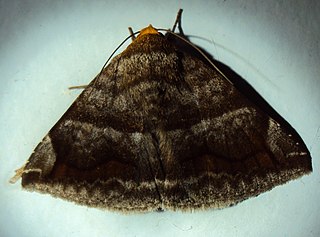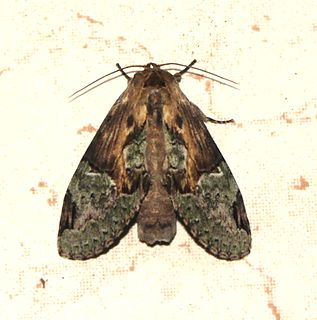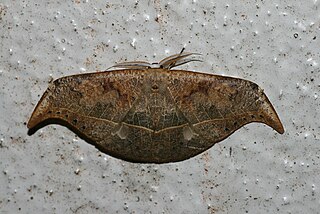
Apamea monoglypha, the dark arches, is a moth of the family Noctuidae. The species was first described by Johann Siegfried Hufnagel in 1766. It is a common, sometimes abundant, European species. It is found in most of Europe except northernmost Fennoscandia and the southern parts of the Iberian Peninsula and Greece. The species is also found in Anatolia, Turkestan, Western Asia and Central Asia, Siberia and Mongolia. In the Alps it is found up to heights of 2,500 meters. The smaller subspecies sardoa is found on Sardinia and Corsica.

Apamea crenata, known as the clouded-bordered brindle, is a moth in the family Noctuidae. It is distributed throughout the Palearctic realm. In the North it crosses the Arctic Circle, in the Mediterranean it is found only in cool locations and mountains avoiding very hot areas. In the Alps, it rises to an altitude of about 2000 metres.

Theretra nessus, the yam hawk moth, is a moth of the family Sphingidae. It was described by Dru Drury in 1773.

Conistra rubiginea, the dotted chestnut, is a moth of the family Noctuidae. The species was first described by Michael Denis and Ignaz Schiffermüller in 1775. It is distributed in Europe and, according to William Warren, Armenia and Asia Minor.

Corcobara is a monotypic moth genus of the family Erebidae first described by Frederic Moore in 1882. Its only species, Corcobara angulipennis, described by the same author in the same year, is found in India, Thailand, Cambodia, Myanmar, Malaysia, Indonesia, New Guinea, Sri Lanka and the Solomons.

Hulodes caranea is a species of moth of the family Erebidae first described by Pieter Cramer in 1780. It is found from India, Sri Lanka, Myanmar, Java, Hong Kong to Queensland and New Guinea, it is also found on the Marianas and Carolines.

Mesapamea secalis, the common rustic, is a moth of the family Noctuidae. The species was first described by Carl Linnaeus in his 1758 10th edition of Systema Naturae. It is found in Europe, north-west Africa, Turkey and northern Iran.

Mythimna decisissima is a moth of the family Noctuidae first described by Francis Walker in 1856. It is found from India across south-east Asia including Hong Kong, Japan, Taiwan and Australia in Queensland and New South Wales. It is also present in South Africa.

Thyas coronata is a species of moth of the family Noctuidae first described by Johan Christian Fabricius in 1775. It is found from the Indo-Australian tropics of southern China, Taiwan, Japan, Nepal, India, Sri Lanka to Micronesia and the Society Islands.

Buzara onelia is a moth of the family Erebidae. It is found from the Indian subregion to Sri Lanka, Myanmar, Sundaland, the Philippines and Japan.

Buzara umbrosa is a moth of the family Erebidae. It is found in China, India and Sri Lanka.

Chalciope mygdon, the triangular-striped moth, is a moth of the family Noctuidae. The species was first described by Pieter Cramer in 1777. It is found from the Oriental region to Sundaland.

Agrochola helvola, the flounced chestnut, is a moth of the family Noctuidae. It was first described by Carl Linnaeus in his landmark 1758 10th edition of Systema Naturae. The species is found in most of Europe, north to Scotland and Fennoscandia up to the Arctic Circle, south to Spain, Sicily, Greece further east to the Middle East, Armenia, Asia Minor, western Turkestan and central Asia up to central Siberia.

Chadisra bipars is a moth of the family Notodontidae. It was described by Francis Walker in 1862 and is found in the Indomalayan realm.

Canucha specularis is a moth of the family Drepanidae described by Frederic Moore in 1879. It is found in Hong Kong, India, southern China, Sundaland and Sulawesi.

Oraesia emarginata is a species of moth of the family Erebidae first described by Johan Christian Fabricius in 1794. It is found in Australia, New Caledonia, Indonesia, New Guinea, Pakistan, the Philippines, India, Sri Lanka, Sulawesi, Taiwan, China, Japan, Korea and Nepal as well as Eritrea, Ethiopia, Kenya, Namibia, Nigeria, South Africa, Tanzania, the Gambia, Uganda, Oman and Yemen.

Fascellina chromataria is a moth in the family Geometridae described by Francis Walker in 1860. It is found in Korea, Japan, Taiwan, China, India, Bhutan and Sri Lanka.

Actinotia intermediata is a species of moth of the family Noctuidae. It is found in Asia, including India, Sri Lanka and Taiwan.

Mesoligia literosa, the rosy minor, is a moth of the family Noctuidae. The species was first described by Adrian Hardy Haworth in 1809. It is found throughout Europe, North Africa and western Asia. and east across the Palearctic to Siberia.

Erygia apicalis is a moth of the family Erebidae first described by Achille Guenée in 1852. It is found from the Indo-Australian tropics of India, Sri Lanka to Japan, Australia and the Solomon Islands. The habitat consists of lowland areas, including dry heath forests and softwood plantations.



















